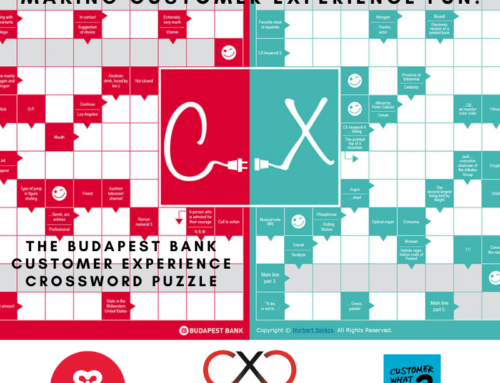
I am often asked how I can conjure up a topic to write about on a weekly basis. Do I have a plan? Do I keep a long list of pre-defined article subjects? Is there a website to stimulate blog ideas? The answer to these questions is ‘no’! In all honesty, my writing is very much inspired by my own experiences – either as a customer in my own right, or by interacting with the many people I have the good fortunate to interact with in practising my vocation! I am regularly hit by a ‘spark’ – a word, or statement, or observation, or conversation – that leads me to mutter to myself, ‘now that will make a good blog post!’. My smartphone has become as important an ‘inspirational blog idea’ capturing tool, as it is a place to make phone calls or surf the web.
Two weeks ago, I travelled to Jordan and Dubai. It was my first visit to Jordan – and a fascinating visit at that – I will explain why in a future post. In Dubai, I was privileged to deliver a Customer Experience ‘keynote’ speech for a company operating in the Financial Services industry. As well as fulfilling my role, my client actively encouraged me to stay with them for the entire day – a day they billed as their CX Summit. The Summit was attended by their customer facing teams operating in the Middle East and North Africa.
The day proved to be incredibly valuable – filled with inspiring and thought provoking speeches, interviews and panel discussions. Whilst there was a lot of content to trigger my writing ‘spark’, it was the panel discussion after lunch that became the inspiration for me to write the very post you are reading now. The panellists having the discussion were among the only attendees of the event who did not work for the client. These panellists were not employees, or consultants, or CX ‘thought leaders’ – they were customers.
I have witnessed customers or clients attending conferences or company events like this before. On occasion, I have interviewed customers in front of the people who deliver the experience to them. It does not actually happen enough, yet when it does, it always proves to be an invaluable (and sometimes uncomfortable) experience for the company concerned.

The four customers on stage had all been customers of this organisation for some time – yet they were completely open and honest about their experiences; what they liked and didn’t like; and how the company made them ‘feel’ in their daily/weekly interactions. There were also very keen to share the things they would like the company to do for them in the future. Towards the end of the discussion, having only answered questions posed to them, one of the customers decided to ask the audience a question of his own:
“As the company supplying me, what do you expect from me as your customer?”
Cue, my blogging ‘spark’! What a question! Organisations spend so much time trying to understand what customers want and expect from them, do they forget to make it clear what they expect from their customers in return? It is a question that requires deeper thinking than you may anticipate. In fact, when the question was asked, there was a significant delay in responding. ‘To give us more business!’, was the first, jovial, response. It became clear that this was a question that had neither been posed to the audience before, nor thought about in any detail.
‘Thinking’, is something that we are rarely afforded the time to be able to spend much time doing in our busy twenty first century lives. In fact, we are so focused on getting things done, or doing ‘stuff’, as I like to describe it, that unless we are encouraged to do so, we will most likely fail to ‘think’ beyond our day to day tasks. If you just take the time to ‘think’ about the question this particular customer posed – what thoughts immediately come to mind? Here are six questions that started to go through mine:
- Does my customer clearly understand what I can do for them, or how I can help them?
- Does my customer know what our ‘desired customer experience’ for them is and what I commit to doing for them as a customer?
- Does my customer have complete clarity as to how my products and services work and what to expect from interacting with them?
- Does my customer know what to do in any circumstance; who to speak to or contact; and how best to make contact?
- Does my customer know what to do if they are not experiencing what they expect, need or want?
- Do I encourage my customer to let me know of any ideas they might have to improve their experience, or for the creation of new products and services?
There is subtle cross over between some of these questions and I am sure that you could add to this list – in fact I encourage you to do so. What do I want from my customers? I want them to have absolute clarity of these six questions and to know that they can and should be able to connect to me, whenever and however they want, to discuss, address and explore the answers. I want my customers to have an open, engaged, ever evolving, continuous, never ending, two-way relationship with me. I don’t want much, do I?!
In my mind, the question this customer posed of my client, allowed me to have the time to ‘think’ and confirm that what I really want from my customer is a relationship. Any relationship – whether it be between two friends, a husband or wife, or a brother and sister, is based on two parties interacting with each other. The word relationship is defined in a number of ways in the dictionary. The two pertinent definitions are as follows:
“the way in which two or more people or things are connected, or the state of being connected.”“the way in which two or more people or groups regard and behave towards each other.”
For a relationship to work, we – that is both parties in the relationship – must work hard to create it, develop it, sustain it, and nurture it. To do that, it requires both parties to engage together. A company must be able to consistently deliver products and services through an experience that meets the customers’ needs, wants and expectations – whilst the customer or client must continuously engage with the company to allow them to understand what works and what doesn’t work, to enable the products, services and experience to be better able to meet their needs, wants and expectations.

There is a word of caution here though – not all customers (like people in real life) are looking for a relationship. They must just want a quick ‘browse’ and just one or two interactions. On that basis, Customer Experience CAN go both ways… but not always.
It sounds and seems so simple – yet simplicity lies behind much Customer Experience theory and practical application. In my opinion, Customer Experience DOES go both ways – at least in long lasting customer relationships, it does. If you want to KEEP your customers and NURTURE a long lasting relationship, why don’t you encourage your own customers or clients to think about the question – “As the company supplying me, what do you expect from me as your customer?” – and further develop your relationship accordingly!






Interesting that the customer was keen to know what the company was expecting – I suspect in the hope that he could in turn get work out what the company was willing to provide in return. The term I like is to describe this as a “Customer Experience Exchange”. As much as we would all like unconditional love the reality is that relations are about exchange and perhaps ever compromise…and so it is with Customer Experience. It’s important to be aware of this because therein lies the secret to longevity and a mutually beneficial relationship. Another interesting question would have been “As a customer what me valuable to you?”